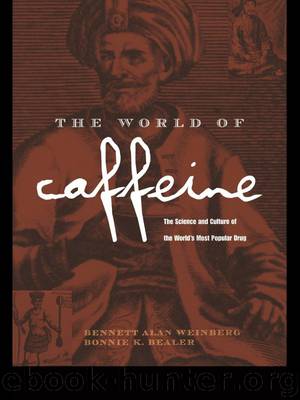The World of Caffeine by Weinberg Bennett Alan Bealer Bonnie K

Author:Weinberg, Bennett Alan, Bealer, Bonnie K. [BENNETT ALAN WEINBERG & BONNIE K. BEALER]
Language: eng
Format: epub
Publisher: Taylor and Francis
Published: 2011-08-01T04:00:00+00:00
Sundblom Santa advertisement for Coca-Cola. This is one of many Sundblom paintings that created the American icon of Santa Claus. The fat, red-nosed, red-cloaked, jolly Coca-Cola-drinking version of Santa Clause became a defining image of American cultural life.
Coca-Cola, the forerunner of all commercially caffeinated soft drinks, was, during its first years, an elixir sold in pharmacies. After the turn of the century, the CocaCola Company had to make a choice as to whether to continue promoting the drink as a tonic, which might suggest it was a strong stimulant with a limited application, or to advertise it as a simple beverage, suitable for everyone, including children. Some Coca-Cola leaders had reservations about the latter strategy, partly because they were concerned over the potential danger to children. However, the simple beverage theory won, even though it meant sacrificing any claim, in the words of executive correspondence, for “excellency or special merit,” and Coca-Cola faced the future as one of many soft drinks.
With this strategy in place, it remained for the company leaders to ensure their product a distinctive place in the arcana of common soda fountain options. One of their central problems remained how to inveigle children into becoming lifelong Coca-Cola drinkers while observing their pledge never to show a child under the age of twelve in an advertisement. While the advertising of Coca-Cola is an epic tale, no single feature stands out as clearly or has had such a broad impact on popular culture as Coca-Cola’s most brilliant response to this apparent dilemma: the invention of the modern Santa Claus.
Santa Claus, as we all know, is a portly, white-haired gentleman with a snowy beard, broad smile, rosy cheeks, red nose, wearing a costume somewhat resembling bright red flannel underwear with a broad belt and big black boots, happily busy with the delivery of toys on snowy Christmas Eves. What many may not realize is that this image of Santa is an American, twentieth-century invention, created by Haddon Sundblom, a Swedish artist in the employ of Coca-Cola, and promoted relentlessly into the apotheosis of a folk hero. Before Sundblom’s work, Santa Claus was represented in a variety of ways. In Europe he had traditionally been a serious, even severe, tall, thin man wearing any of the primary colors. In the popular recitation piece “A Visit from St. Nicholas,” written by Clement Moore, a Columbia University professor, in the 1920s, Santa became a jolly elf only a few inches high.
In their book Dream of Santa, Charles and Taylor relate how in 1931, posing his friend Lou Prentice, a retired salesman, as his first model, Sundblom painted the first depiction of the Santa Claus we know in America today. After Prentice’s death, Sundblom used himself as a model, refining his creation further. The Coca-Cola Company built a small advertising industry around Sundblom’s Coke-guzzling saint, who was invariably aided in completing his eleemosynary labors by the lift provided by sugar and caffeine—an advertising effort aimed, obviously, primarily at young children who would, in the course of things, grow into succeeding generations of CocaCola consumers.
Download
This site does not store any files on its server. We only index and link to content provided by other sites. Please contact the content providers to delete copyright contents if any and email us, we'll remove relevant links or contents immediately.
| Africa | Americas |
| Arctic & Antarctica | Asia |
| Australia & Oceania | Europe |
| Middle East | Russia |
| United States | World |
| Ancient Civilizations | Military |
| Historical Study & Educational Resources |
Cecilia; Or, Memoirs of an Heiress — Volume 1 by Fanny Burney(32028)
Cecilia; Or, Memoirs of an Heiress — Volume 3 by Fanny Burney(31441)
Cecilia; Or, Memoirs of an Heiress — Volume 2 by Fanny Burney(31388)
The Secret History by Donna Tartt(18098)
Sapiens: A Brief History of Humankind by Yuval Noah Harari(13955)
Leonardo da Vinci by Walter Isaacson(12771)
The Radium Girls by Kate Moore(11592)
Sapiens by Yuval Noah Harari(5109)
How Democracies Die by Steven Levitsky & Daniel Ziblatt(4944)
The Wind in My Hair by Masih Alinejad(4828)
Homo Deus: A Brief History of Tomorrow by Yuval Noah Harari(4672)
Endurance: Shackleton's Incredible Voyage by Alfred Lansing(4478)
The Silk Roads by Peter Frankopan(4249)
Man's Search for Meaning by Viktor Frankl(4235)
Millionaire: The Philanderer, Gambler, and Duelist Who Invented Modern Finance by Janet Gleeson(4068)
The Rape of Nanking by Iris Chang(4005)
Hitler in Los Angeles by Steven J. Ross(3790)
Joan of Arc by Mary Gordon(3769)
The Motorcycle Diaries by Ernesto Che Guevara(3766)
